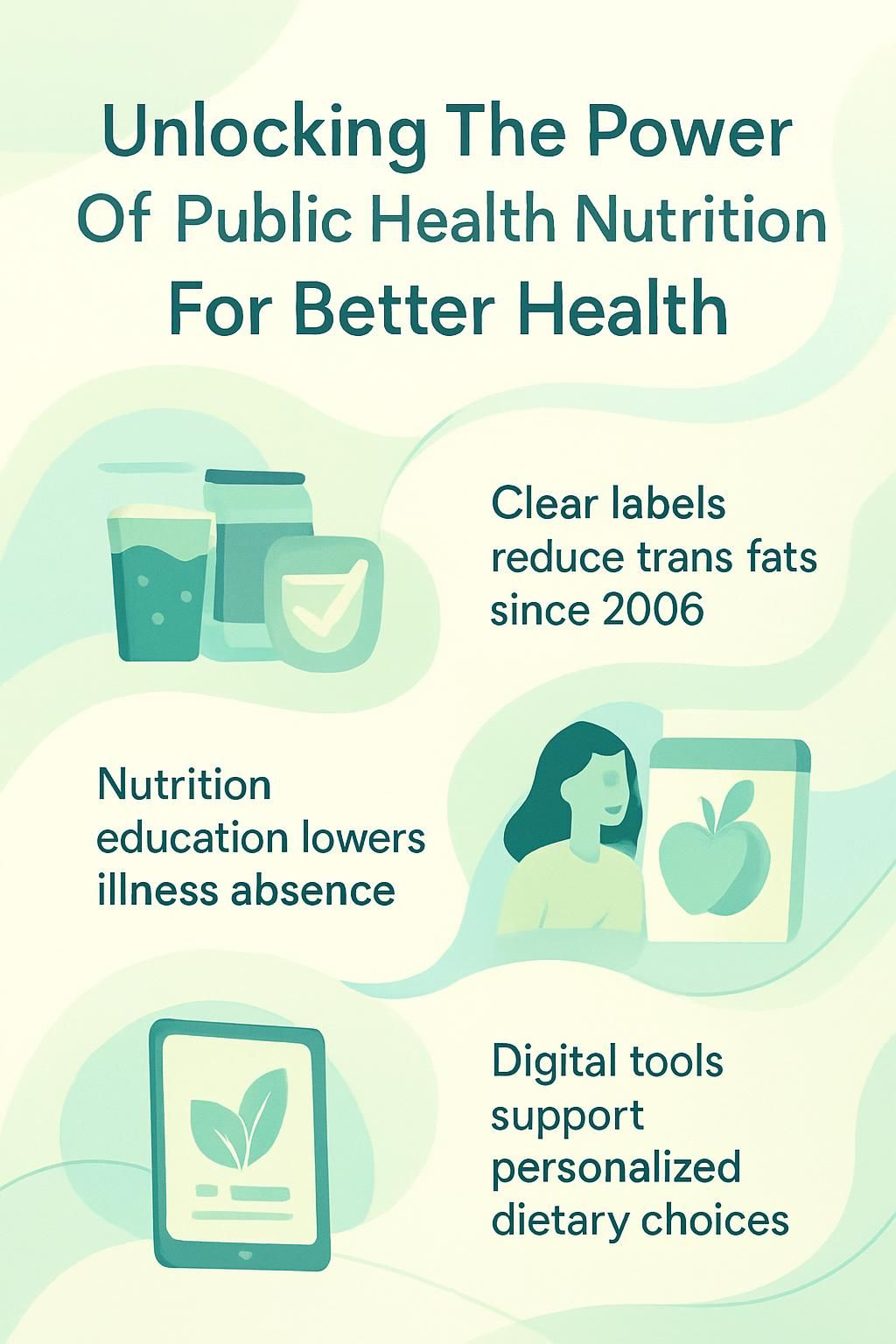Unlocking The Power Of Public Health Nutrition For Better Health
Our Nutrition Assistant AI Suite will transform your body. You will lose fat, get toned, and build muscle. Gain confidence and optimal health.
Worried about rising chronic disease rates like obesity and diabetes? Many people in the United States miss key nutrients that support good health. Public health nutrition offers practical solutions that help communities choose healthier food and prevent disease.
In this guide, you will see how nutrition shapes public health. You will learn proven strategies and simple steps that can improve well-being for you and your community. Small changes can move the needle in meaningful ways.
Disclaimer: This article is for education only. For personal medical advice, consult a licensed clinician or registered dietitian.
Key Takeaways
- Public health nutrition programs lower the risk of heart disease and diabetes by promoting healthy diets and improving access to nutritious foods (CDC).
- Food subsidies such as SNAP and taxes on sugary drinks reduce obesity risk by making healthy options more affordable and less healthy items less appealing. Mexico saw a 7.6 percent drop in soda sales after its tax.
- School nutrition education improves focus, reduces absences, and builds lifelong habits, especially for students from low-income families (WHO; Harvard T.H. Chan School of Public Health).
- Digital tools, precision nutrition, and artificial intelligence offer personalized feedback so people can track nutrients and make better choices.
- Clear labeling rules since 2006 cut trans fats in U.S. foods, which reduced heart disease risk by giving shoppers better information at the shelf.

Understanding Public Health Nutrition

Public health nutrition studies how food patterns shape health across whole communities. Students in a school of public health or an MPH program learn to prevent chronic disease through policy, education, and access to healthy food.
What is public health nutrition and its scope?
Public health nutrition aims to improve population health using food and lifestyle strategies. The work includes analyzing food policies, spotting risk factors, and building interventions for issues like childhood obesity, malnutrition, and diabetes prevention.
Efforts may include school meal upgrades or pushing for healthier food environments in neighborhoods. Nutrition epidemiology, the study of diet and health patterns in populations, supplies data on trends such as rising obesity or low omega-3 intake. That evidence guides programs that target specific problems.
The scope stretches from national policy to counseling in local clinics. It covers all ages, from maternal and child health to nutrition support for older adults.
During my master of public health training, teamwork among dietitians, policy makers, and teachers reduced gaps tied to food access, food marketing, and the social determinants of health. Many projects also include physical activity and food security research.
Nutrition is not just about eating, it is about learning to live.
How does nutrition impact public health?
A healthy diet lowers the risk of cardiovascular disease, obesity, and type 2 diabetes. The CDC reports that poor diet contributes to four of the top ten causes of death in the United States.
Where fresh food is limited or costly, health disparities grow. Choosing fruits, vegetables, whole grains, and lean proteins while limiting junk food supports prevention and daily function.
Schools that teach healthy habits often see better focus and behavior. The WHO notes that improved maternal nutrition can cut low birth weight by up to 32 percent.
While volunteering with a local program, I saw families with affordable produce experience fewer diet-related illnesses over time. Community education empowers people to make informed choices that support both physical and mental health.
Key Principles of Public Health Nutrition
Core principles guide health promotion and disease prevention. Coursework, practice experience, and research build your competency in this field.
How can healthy eating habits be promoted?
Promoting healthy eating reduces poor health outcomes and prevents disease. Effective public health efforts address both individuals and entire communities.
- Provide nutrition education in schools so students learn about balanced meals with fruits, vegetables, and whole grains.
- Use clear food labeling rules to help people compare calories and nutrients at stores and restaurants.
- Offer community classes and farmers markets to build cooking skills and increase access to fresh produce.
- Support policies that subsidize fruits, vegetables, and low-fat dairy to ease cost barriers for low-income families.
- Strengthen school meal standards so lunches follow dietary guidelines and build lifelong habits.
- Promote breastfeeding through workplace support and maternal education; it lowers infant obesity risk and supports maternal health.
- Leverage digital tools and wearables so users can track intake, set goals, and get feedback from registered dietitians.
- Advocate for taxes on high-sugar or high-fat foods; research shows these taxes can cut sugary drink sales by 10 to 20 percent.
- Ensure access to clean water in public places like parks, schools, and clinics to nudge healthier daily choices.
- Partner with local practitioners and public health nutritionists to provide screenings and healthy cooking workshops.
At a recent community event, label-reading demos helped many attendees feel more confident choosing better snacks.
Sources:
- Centers for Disease Control and Prevention (CDC). “Strategies to Prevent Obesity.”
- Harvard T.H. Chan School of Public Health. “Food Policy & Obesity.”
What are the nutrition-related health disparities?
Many neighborhoods face disparities in nutrition due to income, education, and access. Lower-income areas often lack full-service grocery stores and fresh options.
Studies show families with lower incomes spend about $1.50 less per day on nutritious foods. This gap raises risk for obesity and type 2 diabetes.
Some students miss quality nutrition education, which limits healthy habit formation. Racial and ethnic minority groups also face higher rates of diet-related conditions. For example, Black adults are about 60 percent more likely than White adults to be diagnosed with diabetes linked to diet.
In my public health practice work, language barriers kept some families from using WIC or SNAP. These obstacles show why community-based programs are vital to reduce disparities.
How does diet support preventive healthcare?
Improving diet is a powerful form of preventive healthcare. Eating fiber-rich foods such as fruits, vegetables, and whole grains can lower heart disease risk by about 20 percent. Potassium-rich foods support healthy blood pressure.
Students in a public health nutrition concentration learn that specific diets help prevent disease before it starts. Cutting saturated fat improves cholesterol. Combining daily physical activity with a nutrient-dense diet can reduce type 2 diabetes risk by nearly 60 percent in major studies.
Community programs and school education make these changes easier to start and maintain over time.
The Impact of Public Health Nutrition on Health Outcomes
Nutrition shapes chronic disease risk and community wellness. A few focused actions can boost long-term health.
How does public health nutrition reduce chronic diseases?
Effective programs improve access to healthy food, promote balanced meals, and connect diet with physical activity. A community effort might increase fruit and vegetable intake or limit added sugar in school meals.
Healthcare organizations use evidence-based strategies to reduce risk at the population level. Higher fiber intake can lower cardiovascular disease risk by up to 16 percent.
Professionals with an MPH in public health nutrition use data and targeted education to guide change. Healthier food environments support obesity prevention and better outcomes over time.
How does it improve maternal and child health?
Strong nutrition during pregnancy supports fetal growth. Iron and folic acid reduce anemia and birth defects. Breastfeeding support boosts infant immunity and lowers mortality risk.
Children who receive balanced meals are less likely to have stunted growth or frequent infections. In global public health, these strategies also improve school attendance and learning.
Program managers with training in public health nutrition and dietetics plan efforts that improve birth outcomes now and cognitive development later.
What is the effect on mental health and cognitive development?
Balanced diets support brain function and mood. Students with better nutrition score higher and concentrate longer. Diets rich in produce, lean proteins, and whole grains aid memory and problem solving.
Lack of key nutrients like iron, iodine, and omega-3s can slow brain development and make learning harder. Eating breakfast is linked to better test scores and less anxiety.
Heavy intake of processed foods raises risk for depression and low energy. Public health nutrition works to make nutrient-rich foods available in schools and neighborhoods to support mental well-being across all ages.
Strategies for Effective Public Health Nutrition Programs
Stronger environments and clear messages help people build healthier habits. Think of these strategies as a community playbook.
What are community-based nutrition interventions?
Local programs improve eating patterns using shared resources and practical education.
- Community groups host cooking classes that teach meal planning with affordable ingredients.
- Regular nutrition sessions in schools and centers raise awareness about balanced diets.
- Community gardens increase access to fresh produce for families.
- Mobile food pantries bring fruits, vegetables, and grains to areas without nearby stores.
- Peer support groups led by students or professionals help people set goals and track progress.
- Public campaigns use posters and social media to share simple nutrition facts.
- Food policy councils work with local leaders to reduce food deserts and improve options.
- Many programs track results with surveys or BMI checks before and after participation.
- In one MPH elective, our team brought dietitians into schools. Kids got excited to taste new fruits.
These efforts build lasting habits and healthier norms across the neighborhood.
How does school-based nutrition education work?
Schools are ideal places to teach lifelong skills. Programs blend classroom lessons with hands-on activities and family support.
- Teachers include nutrition in health or science classes, aligned with public health nutrition MPH program goals.
- Age-appropriate visuals explain food groups, portions, and balanced meals.
- School gardens let students grow vegetables and connect food choices with health.
- Cafeterias feature clear labels and healthy options for daily decision-making.
- Guest nutrition professionals share practical tips for smart snacking at home.
- Family events and newsletters help parents reinforce these habits.
- Schools measure progress with short surveys or quizzes to improve future lessons.
- State public health partners align resources with national dietary guidelines and recent research.
- Peer-led activities allow older students to mentor younger ones.
I once helped fifth graders cook simple meals in class. Many began reading labels with their families afterward.
What policy initiatives create healthier food environments?
Policies make healthy choices easier and more affordable for everyone.
- Set limits on salt, trans fats, and added sugars to reduce chronic disease risk.
- Require clear Nutrition Facts so shoppers can compare calories, sugar, and fat quickly.
- Offer tax incentives to stores that expand produce and whole grain options in underserved areas.
- Use zoning to limit fast-food outlets near schools to lower exposure to unhealthy items.
- Update school meal standards so lunches include lean proteins, whole grains, and produce.
- Subsidize farms that grow fruits and vegetables to lower prices at markets.
- Place taxes on sugary drinks or junk food to shift choices toward healthier items.
- Restrict ads for high-sugar or high-fat foods during children’s programming.
These policies reshape the food landscape so the healthy choice feels like the easy choice.
The Role of Nutrition Policies in Public Health
Nutrition policies set fair rules that help people access and choose healthy food.
How do food labeling and regulations affect nutrition?
Food labeling helps you judge what is in a product at a glance. Labels list calories, sugars, fats, and serving sizes in a standard format. After trans fat labeling became mandatory in 2006, many producers removed or reduced these fats.
Regulations also reduce misleading health claims. You can spot items high in salt or added sugar by reading the label. As a parent, allergen warnings have helped me avoid risks for a child with food allergies.
These steps support healthier patterns across communities because more shoppers understand what they buy.
Key Stats:
| Label Feature | Year Introduced | Health Impact |
|---|---|---|
| Trans Fat Listing | 2006 | Lowered heart disease risk |
| Allergen Warning | 2004 | Improved safety for those with allergies |
Clear labels give you power over daily food choices and advance public health goals nationwide.
What are subsidies for nutritious foods?
Subsidies lower the price of healthy items like fruits, vegetables, whole grains, and low-fat dairy. Governments fund farmers or retailers so these foods cost less at checkout.
Programs such as SNAP help families add more produce to meals. In my city, grocery coupons from a community program made it easier to bring home fresh fruit each week.
Lower prices increase access and can reduce obesity and chronic disease across communities.
How does taxing unhealthy foods influence health?
Taxes on sugary drinks or ultra-processed snacks change buying habits. In Mexico, soda sales fell 7.6 percent in the first two years after the tax, with the biggest drops in low-income households.
Higher prices push choices toward water, fruits, and vegetables. Schools often sell fewer sweetened drinks when such taxes are in place.
In my neighborhood, price changes led to fewer chip purchases at school markets. Taxes can also fund health programs and education. Combining taxes with subsidies makes healthy foods easier to choose while discouraging less healthy options.
Innovations in Public Health Nutrition
New tools make it simpler to track what you eat and build better habits.
How do digital health tools track nutrition?
Apps let you log meals, scan barcodes, and view nutrition facts like calories and vitamins. Some estimate portion sizes from photos. Others sync with wearables to track activity in real time.
Set goals for calories, protein, or fiber. The app compares your intake with targets and offers feedback. Reminders and meal plans help you stay on track and spot nutrient gaps.
What are precision nutrition approaches?
Precision nutrition customizes advice using your genetics, lifestyle, environment, and health data. DNA tests and food logs can show which foods support your metabolism or where deficiencies exist.
Some gene variants suggest higher folic acid needs. Others point to better results on lower-fat diets. Researchers estimate that many adults have genes linked to different nutrient needs. Wearables and apps help collect real-time data to sharpen recommendations.
Instead of broad rules, you receive specific tips aligned with your profile.
How is artificial intelligence used in nutrition planning?
Artificial intelligence reviews large datasets from food diaries, health records, and wearables to spot patterns. Apps compare your meals with guidelines and flag nutrient gaps using machine learning.
Barcode scans and meal photos can be analyzed in seconds. Some platforms suggest recipes that fit allergies or preferences. Using an AI tracker helped me raise fiber and cut salt with less effort.
Studies suggest AI-guided plans can improve healthy eating behaviors in schools and clinics compared with manual methods.
The Role of Public Health Nutrition Professionals
These professionals shape policy, educate communities, and guide programs that make healthy eating possible.
What are the responsibilities and skills needed?
Public health nutrition professionals design and manage community programs. They collect data on eating patterns, analyze trends, and assess needs.
Clear communication helps them teach healthy choices. Teamwork with schools, local leaders, and healthcare workers expands reach. Strong research skills support evidence-based strategies, and problem-solving addresses barriers like food insecurity and cultural preferences.
I once worked with a school district to improve lunch menus. Explaining the benefits clearly helped win support from parents and teachers.
What training and education programs exist?
Several pathways prepare you for this career. Each adds knowledge and practical skills for community nutrition challenges.
- Bachelor’s programs in Public Health or Nutrition cover human nutrition, promotion, and epidemiology.
- MPH degrees with a Nutrition concentration integrate policy, population health, and biostatistics, often with a practicum.
- Dietetic Internships provide supervised practice needed to become a Registered Dietitian Nutritionist (RDN).
- Certificates in areas like food safety, pediatric nutrition, or chronic disease prevention strengthen practice skills.
- Continuing education keeps licensed professionals current through seminars and workshops.
- Fellowships offer advanced research experience at major centers or government agencies.
- Doctoral programs focus on research methods, program evaluation, and policy analysis for leadership roles.
These options let you build the mix of science, policy, and practice needed for impact.
What career opportunities are available?
Career paths include community nutritionist roles that support neighborhood health. Hospitals hire public health dietitians to design wellness programs.
Schools need educators to teach healthy choices. Government agencies employ specialists in policy analysis and program management for SNAP or WIC. Nonprofits recruit outreach coordinators for hunger relief and maternal-child health projects.
Universities and research groups analyze diet data that inform national guidance. Global health organizations such as UNICEF and WHO seek experts for malnutrition prevention and emergency feeding. Food companies also hire professionals to improve products using scientific evidence.
All of these roles help communities move toward healthier eating through evidence-based action.
Challenges in Implementing Public Health Nutrition
Funding limits, resource gaps, and social factors can slow progress. Cultural beliefs and community norms also shape how diet changes take hold.
How is food insecurity addressed?
Food insecurity harms health and learning. Public health programs use multiple strategies to increase access to healthy food.
- Food banks provide fresh produce and staples, often partnering with farms and grocers to reduce waste.
- SNAP and WIC offer resources to low-income households. In 2023, SNAP supported over 42 million Americans.
- School meal programs serve balanced breakfasts and lunches to millions of students each year.
- Mobile markets deliver produce to neighborhoods without nearby supermarkets.
- Nutrition education teaches label reading and budget-friendly cooking skills.
- Urban agriculture projects, such as community gardens and rooftop farms, bring produce closer to residents.
- Healthcare and pantry partnerships offer “food prescriptions” based on clinical needs.
- Advocacy groups push policies that address poverty, prices, and transportation barriers.
- At a community kitchen where I volunteered, immediate meals paired with cooking lessons helped families build long-term skills.
Together, direct aid and policy change improve food security and health equity.
What cultural and social barriers exist?
Cultural and social forces shape food choices and access to healthy options.
- Traditional dishes may not meet current nutrition needs without small adjustments.
- Social stigma can discourage healthy choices if group norms favor processed foods.
- Language barriers limit access to nutrition information and services.
- Religious practices may restrict certain foods, which requires individual guidance.
- Household roles can slow change if one person controls meals and shopping.
- Limited budgets push families toward cheaper, less nutritious options.
- Misinformation spreads quickly on social media and can fuel myths.
- Peer pressure at school or work often drives snack choices.
- Rural areas may face long trips for fresh produce, unlike some cities with many stores.
Addressing these barriers with respect and clear communication leads to better results.
How to overcome funding and resource limitations?
Programs succeed by combining smart funding, partnerships, and low-cost tools.
- Apply for grants from the CDC, USDA, or NIH to support nutrition projects.
- Build partnerships with businesses, nonprofits, and universities to share resources.
- Recruit volunteers to expand reach without raising costs.
- Use free apps and open-source tools for education, planning, and progress tracking.
- Focus on low-cost, high-impact steps such as school gardens and cooking classes.
- Support policy efforts that secure long-term public funding.
- Measure impact with simple metrics so funders see clear results.
Real-world examples show that even modest budgets can produce measurable gains.
Real-World Examples of Public Health Nutrition Success
Across the globe, targeted programs and strong partnerships have improved health. These cases offer practical ideas you can adapt.
What are some global program case studies?
Many countries have scaled strategies that improve nutrition and reduce disease.
- Brazil’s “Fome Zero” combined school meals, assistance, and family farming. More than 13 million people left extreme poverty and childhood malnutrition fell from 2003 to 2014.
- Bangladesh’s National Nutrition Program used clinics, vitamin A, and counseling. UNICEF reports vitamin A coverage above 90 percent for children under five.
- The United States WIC program supports low-income women and young children with supplemental foods, education, and referrals. Nearly half of U.S. infants benefit each year.
- The SUN Movement links 60-plus countries to address malnutrition with fortified foods and nutrition-sensitive agriculture.
- Mexico’s sugary drink tax cut purchases by about 7 percent after one year while water sales rose.
- Kenya’s Community Health Strategy trains workers for home-based counseling on breastfeeding and growth monitoring, reducing stunting.
- India’s ICDS program delivers midday meals and micronutrients to millions of mothers and children.
These efforts use data, community engagement, smart policy, and direct aid to drive change.
How do breastfeeding promotion initiatives impact health?
Breastfeeding promotion improves health for infants and mothers. Exclusive breastfeeding for six months provides key nutrients and antibodies, and reduces risks for infections, obesity, diabetes, and SIDS. The WHO recommends this practice for strong early development.
At a local clinic, educators taught new mothers how to breastfeed and where to find help. Rates of childhood illness dropped within a year. Mothers also see lower risk for breast and ovarian cancers. UNICEF reports major healthcare savings in places that invest in breastfeeding education.
Peer counseling, group classes, and hospital support programs raise success rates across communities.
What community efforts reduce malnutrition?
Local food banks, community kitchens, and urban gardens provide direct access to healthy foods and teach practical skills. Feeding America reports that more than 53 million people used food pantries in 2021.
Community centers often host classes on preparing balanced meals on a budget. Many groups also distribute culturally familiar foods to meet nutrient needs while respecting traditions.
In my city, school gardens taught children how to grow and taste vegetables they planted. That hands-on experience built interest in eating more produce.
These grassroots efforts reduce disparities and strengthen nutrition for all ages.
The Future of Public Health Nutrition
As research and technology advance, teams can deliver smarter, faster solutions that meet real needs.
Why are interdisciplinary collaborations needed?
Complex nutrition challenges require many skills. Nutrition experts, clinicians, policy makers, educators, and community leaders each hold part of the solution.
For example, a school district can partner with a dietitian and social worker to address obesity and food insecurity at once. In a city project I joined, planners, farmers, and dietitians worked together to open more community markets in low-income areas.
Sharing data and resources improves results and speeds progress.
How can nutrition epidemiology research advance?
Larger and more diverse studies will build stronger evidence. Digital tools can track eating in real time so researchers collect accurate data on intake and outcomes.
Artificial intelligence helps analyze large datasets quickly. Cross-field teams, including medicine, genetics, and data science, improve study design. Precision nutrition blends genetics with lifestyle, which leads to more personal guidance.
Open data and better methods, including randomized trials, will increase trust and impact.
How to scale successful interventions globally?
Partner first with local leaders, schools, and agencies. Adapt successful models to fit local culture, foods, and schedules. Share clear results with WHO or UNICEF to gain funding and visibility.
Train local workers well so delivery stays consistent. Use digital platforms to monitor outcomes and adjust fast. On a vitamin program in rural India, involving teachers improved parent trust and child participation.
Seek government grants and public-private partnerships to expand reach. Improve supply chains so healthy foods arrive on time and at fair prices. Share lessons at conferences and in journals to help others replicate success.
Conclusion
Public health nutrition helps build healthier communities and lowers disease risk. Support smart nutrition policies, choose healthy meals, and promote better food environments where you live and learn. Each step strengthens your health and supports your neighbors too.
Small actions add up. Start today to protect your future and advance public health for everyone.
FAQs
1. What is public health nutrition and why is it important for better health?
Public health nutrition focuses on improving the eating habits of groups to prevent disease and promote wellness. It uses research and data to guide food choices, helping communities lower the risk of chronic illnesses like heart disease and diabetes. For example, a study from the Centers for Disease Control and Prevention showed that balanced diets can reduce obesity rates by up to 20 percent in some areas.
2. How does public health nutrition use evidence-based strategies?
Public health nutrition relies on scientific studies and credible sources. Experts review large surveys and clinical trials to find which foods or nutrients help people stay healthy. For instance, a 2022 report from the World Health Organization highlighted that increasing fruit and vegetable intake can cut heart disease risk by 30 percent.
3. What are some key nutrients promoted in public health nutrition?
Key nutrients include vitamins, minerals, fiber, and healthy fats. These nutrients support growth, brain function, and disease prevention. Here is a simple table showing examples:
Nutrient| Example Foods
—————-|————————–
Vitamin C | Oranges, bell peppers
Fiber | Oats, beans
Calcium | Milk, leafy greens
Healthy Fats| Salmon, walnuts
4. How can individuals apply public health nutrition in daily life?
People can use public health nutrition by choosing whole foods, reading nutrition labels, and following local dietary guidelines. For example, I started planning meals with more vegetables and whole grains after learning about their benefits in a nutrition class. This change helped me feel more energetic and improved my focus at work.
Summary: Public health nutrition uses science to guide healthy eating for groups. Evidence shows that balanced diets with key nutrients can prevent disease. Simple changes in daily habits can lead to better health for individuals and communities.







